Comprehensive Guide to Seedling Identification


Intro
Understanding seedlings is like getting to know the roots of a thriving garden. Recognizing the diverse forms of seedlings not only helps in cultivating successful plants but also ensures a flourishing ecosystem. In this guide, we dive into the intricate world of seedlings, unveiling their morphology, growth habits, and the significant role they play in agriculture and horticulture.
Seedlings are the first signs of life that emerge from a seed. Their identification is paramount for anyone involved in plant care, whether you are a professional agriculturalist, an avid gardener, or merely someone with a green thumb. Knowing your seedlings can mean the difference between success and failure in your gardening endeavors.
Get ready to embark on a journey to distinguish one seedling from another. This guide is tailored for you, offering insights that can transition a curious beginner into a knowledgeable plant caretaker, while also serving as a resource for seasoned gardeners seeking to refresh their skills.
Prelims to Seedling Identification
Understanding seedlings is a vital piece of the agricultural puzzle. Seedling identification enhances not just a farmer's ability to cultivate crops, but also a gardener's passion for nurturing plants. Recognizing and accurately identifying seedlings opens doors to a more profound comprehension of plant biology, environmental interactions, and the specific requirements for growth. This knowledge fosters better practices, as the ability to distinguish between various seedlings leads to improved plant health and, ultimately, a better yield.
Importance of Seedling Identification
The identification of seedlings is no small potatoes, serving multiple purposes. First off, knowing what each seedling represents helps avoid costly mistakes in planting. If a farmer mistakenly plants a seedling known for its invasive tendencies, it could spell disaster for local ecosystems. Identifying seedlings effectively allows for proper management of crop rotation as well as avoiding competition for resources among plants, which is crucial in a world where every drop of water counts.
Beyond agriculture, a keen understanding of seedlings can be pivotal in ecological restoration projects. Native seedlings, for instance, provide the best chances for local wildlife to thrive, supporting the intricate web of life around them.
"By recognizing the differences in seedlings, we can foster sustainable practices that not only benefit our farms but also the planet."
Having a robust guide in hand makes a world of difference for both seasoned green thumbs and newcomers to the plant world. The benefits extend to enthusiasts wanting to create beautiful gardens, providing a means to select suitable plants that flourish in specific environments.
Overview of Seedling Development Stages
Let’s break down the journey from seed to seedling. Seedlings go through distinct stages as they develop. This growth journey begins with germination, where seeds sprout and roots anchor into the soil, absorbing crucial nutrients.
After germination, seedlings move into the seedling stage. During this somewhat fragile phase, they begin to establish their leaf structure and root system. Identifying seedlings at this point can be tricky, yet it’s essential. Recognizing the unique characteristics of each stage allows for timely intervention, whether that’s providing extra nutrients or ensuring they aren't overshadowed by faster-growing neighbors.
Finally, as seedlings mature, they progress into the vegetative stage where they establish more leaves and develop sturdier roots. These changes are often visible, and the proficiency in identifying these stages can significantly influence management decisions, plant spacing, and future care routines.
From recognizing the different phases to understanding their needs, grasping the full spectrum of seedling development offers invaluable insights—critical for anyone passionate about cultivating plants.
Morphological Characteristics of Seedlings
The morphological characteristics of seedlings are pivotal in the quest for accurate seedling identification. These features provide insights into a seedling’s growth potential and adaptability to various environments. Observing the form and structure of seedlings can often reveal much about their species and expected behavior in different cultivation scenarios. For instance, a farmer could determine the best care tactics based on specific morphological traits, leading to more successful growing outcomes.
Leaf Structure and Arrangement
Types of Leaves
In the world of seedlings, the types of leaves can heavily influence identification practices. The distinction between broadleaf, needle-like, or scale-like leaves can point to different plant families. Broadleaf seedlings, those with wider surfaces, are usually beneficial for shading soil and reducing evaporation. This characteristic makes them a popular choice for farmers aiming for sustainable practices. Another interesting aspect is that broadleaf plants often find their niche in more temperate regions, allowing them to flourish where competition is fierce.
Unique feature: Leaf shape plays a big role too. For instance, lobed leaves, like those of oak seedlings, not only contribute to photosynthesis efficiency but also serve specific ecological functions such as providing habitats for various organisms.
- Advantages: Broad leaves capture sunlight effectively.
- Disadvantages: Some types may be more susceptible to pests or diseases.
Leaf Venation Patterns
Leaf venation patterns bring additional layers into the identification mix. Understanding the arrangement of veins within leaves—whether it’s pinnate or palmate—can provide significant clues about a seedling’s identity. For instance, many hardwood species have distinct patterns that can guide horticulturists when they are out in the field.
Key characteristic: Leaves with complex venation can be beneficial as they allow for efficient nutrient transport, which is essential for young plants.
- Advantages: Accurate identification based on venation ensures proper care, as each plant type may have different needs.
- Disadvantages: Some patterns may be confusing and require a detailed understanding to decipher correctly.
Root System Types
Fibrous vs. Tap Roots
Roots are the unsung heroes of seedlings, laying the groundwork—quite literally—for their growth. Understanding the differences between fibrous and tap roots is crucial for anyone looking to properly care for their plants. Fibrous roots tend to spread out and capture water and nutrients from the topsoil, while tap roots dive deeper, sharing an ability to access moisture and nutrients from the ground. This profound distinction aids farmers in altering irrigation strategies depending on root structure.
Key characteristic: Deep tap roots can be an asset during drought, while fibrous roots may offer advantages in nutrient uptake.
- Advantages: Fibrous roots support better anchoring, useful for windy environments.
- Disadvantages: Tap roots may struggle in compacted soil.
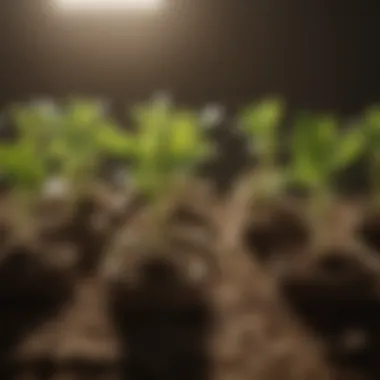
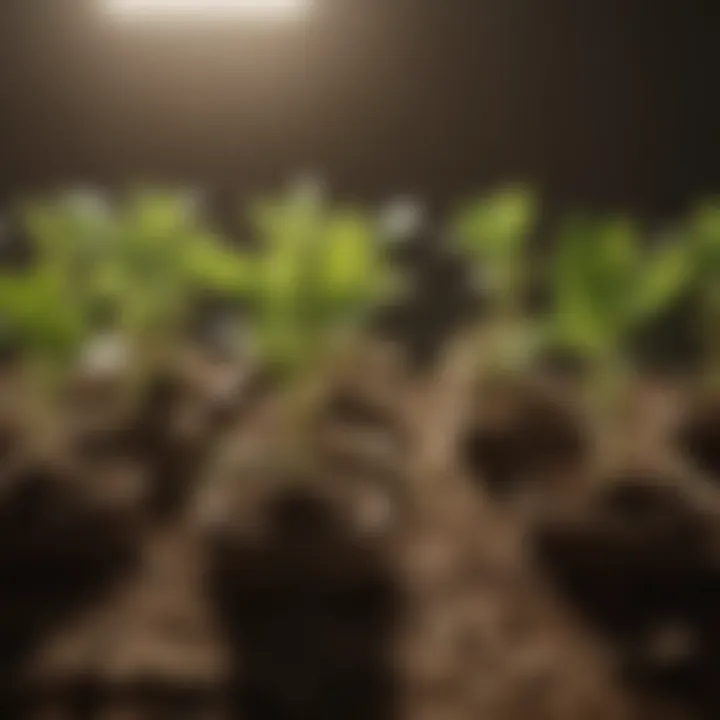
Adventitious Roots
Adventitious roots are intriguing for their ability to sprout from stems or leaves rather than the typical root zone. This adaptability can significantly influence how a plant responds to stress and its ability to propagate. For many gardeners, recognizing these roots can lead to a better understanding of how to propagate plants or manage their growth effectively.
Key characteristic: Adventitious roots can help in stabilizing plants on sloped terrains.
- Advantages: They can enhance a plant's resilience.
- Disadvantages: They may also complicate maintenance if not managed correctly.
Stem Characteristics
Determining Stem Thickness
The thickness of a seedling's stem provides clues about its age and health. A sturdy, thick stem is often an indicator of a robust plant that has effectively established itself. Thin stems, meanwhile, may suggest youth or stressors affecting growth. For identification purposes, thickness lends insight into the allocation of resources within the plant.
Key characteristic: A thicker stem can generally support more extensive foliage, but it can also indicate storing more nutrients.
- Advantages: Thick stems tend to be more durable against environmental challenges.
- Disadvantages: In certain species, excessive thickness may hinder resource transport.
Node and Internode Identification
Knowing how to identify nodes and internodes bolsters understanding of a seedling’s overall health and growth pattern. Nodes are essential for growth as they are the points from where leaves and shoots emerge, while internodes signify the spaces in between. This information is valuable in predicting how a plant may respond to pruning or environmental factors.
Key characteristic: The distance between nodes can reflect how a plant adapts to its light environment; closer nodes often indicate crowding and competition.
- Advantages: This knowledge can help in training growth or in strategic plant spacing.
- Disadvantages: Misinterpretation may lead to inappropriate cultivation practices.
Each morphological trait is a puzzle piece that collectively portrays the broader picture of a seedling's potential, environmentally and agriculturally. Understanding these characteristics plays a critical role in the successful cultivation and care of various plants.
Ecological Considerations in Identification
When it comes to identifying seedlings, paying attention to ecological factors is as crucial as leaf shape or root structure. Plants are not just independent entities; they respond to their surroundings in complex ways. Understanding these ecological considerations helps in making informed decisions about planting, cultivation, and overall plant care. By grasping the relationship between seedlings and their environments, agriculturalists and garden enthusiasts can not only enhance their identification skills but also contribute to sustainable farming practices.
Soil Type and Conditions
Soil is the foundation of any thriving ecosystem, and seedlings are deeply influenced by the type and quality of the soil they sprout from. Different seedlings flourish in different soil conditions due to variations in texture, drainage, and nutrient availability.
- Texture: Sandy soils, with their larger particles, drain quickly, making them ideal for drought-tolerant plants but challenging for those that require more moisture.
- Nutrient Content: Seedlings like tomatoes or carrots prefer nutrient-rich loamy soil to grow strong and healthy. Without proper nutrients, seedlings can become weak and struggle to establish themselves.
Additionally, soil pH plays a significant role in seedling health. Some seedlings, like blueberries, thrive in acidic soils, while others, such as lilacs, prefer more alkaline conditions. Therefore, understanding the specific soil requirements of the seedlings one wishes to grow can dramatically improve their chances for success.
Climate and Growth Environment
Temperature Ranges
Temperature is one of the critical environmental factors affecting seedling development. Different species have specific temperature ranges that are optimal for their growth. For instance, warm-season crops like corn perform well when daytime temperatures soar, while cool-season varieties such as kale prefer the refreshing embrace of spring and fall temperatures.
A key characteristic of temperature influence is the rate of seedling germination. Warmer conditions can expedite this process, leading to quicker growth, but there can be a drawback. Excessively high temperatures can stress seedlings, resulting in stunted growth or even death. This highlights the importance of monitoring temperatures—especially in regions experiencing climate fluctuations. Aligning planting schedules with temperature patterns can stabilize seedling establishment.
Thus, understanding temperature behavior is beneficial for selecting the right time to sow seeds and for more effective cultivation.
Humidity Levels
Humidity is another atmospheric parameter that plays a pivotal role in seedling success. Different plants have varied tolerance to moisture in the air. High humidity levels can promote rapid growth for certain seedlings by facilitating transpiration—an essential process where plants release water vapor.
However, too much humidity can lead to fungal diseases, particularly in densely planted areas. Seedlings like ferns might thrive under humid conditions, while others might cramp under the same circumstances. The fluctuating humidity levels can, therefore, create a mixed bag of challenges and advantages, depending on the seedlings in question.
Understanding these dynamics allows farmers and gardeners to manipulate their growing environments—whether by adjusting irrigation practices or fitting seedling selection to regional climatic conditions.
"The success of your seedlings greatly hinges on understanding the ecology around them—soil and climate are key partners in their growth dance."
In summary, observing ecological considerations in seedling identification provides insights that cut across various aspects like soil type and climate conditions. This holistic understanding forms the backbone of effective plant cultivation and sustainable agricultural practices.
Regions and Native Seedling Varieties
Understanding the significance of regions and native seedling varieties is paramount for any agriculture-focused individual. When cultivating plants, knowing which seedlings are indigenous to specific climates can dramatically influence the success of growth and sustainability. By recognizing the relationship between a seedling and its native environment, one can harness natural adaptability and resilience.
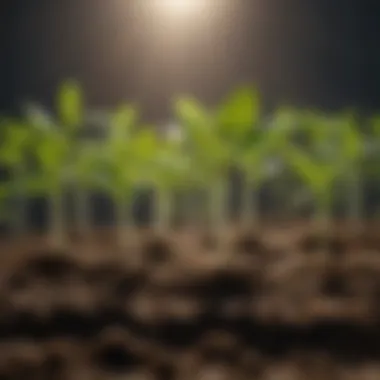
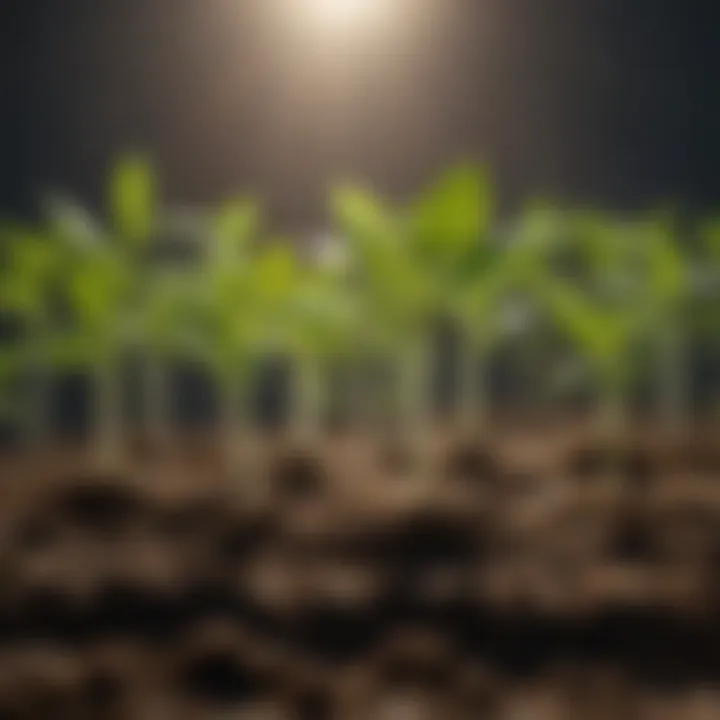
Seedlings Indigenous to Different Climates
Seedlings grow best in environments that are suited to their specific characteristics. Just as people feel more at home in their native places, seedlings thrive when planted in soils, temperature ranges, and humidity levels they are accustomed to. For instance, the Eastern Red Cedar, which originates from the eastern United States, enjoys the warm, humid conditions typical of its home turf. Conversely, Saguaro Cactus, found in the arid desert regions of Arizona, is adapted to survive with minimal water.
These indigenous seedlings often come packed with traits that let them resist local pests and diseases. Let’s say you’re planting in the Mediterranean region; using seedlings like Olive trees and Grapevines can lead to a fruitful yield, as they are adapted to facing the Mediterranean climate. Rows of them can flourish where non-native varieties might just throw in the towel.
Moreover, recognizing these indigenous seedlings can assist in combating soil erosion and enhancing local biodiversity. By incorporating native varieties into planting schemes, landowners can bolster the ecosystem's health, encouraging pollinators and other beneficial organisms to settle in.
Benefits of Using Native Seedlings
Opting for native seedlings offers a bouquet of benefits, some of which are crucial for sustainable practices:
- Low Maintenance: Native plants are already adapted to local soils and climate conditions, requiring less water and fewer fertilizers. This means reduced costs and lower environmental impact.
- Biodiversity Enhancement: Introducing native seedlings helps re-establish local flora and fauna, which can improve overall ecosystem functionality.
- Resilience to Local Pests: Since natives have evolved alongside local pests, they often have natural defense mechanisms in place, minimizing the need for chemical interventions.
- Supporting Wildlife: Native plants provide food and habitat for native wildlife, including bees and butterflies that are essential for pollination.
Using native varieties isn’t just a trend; it’s a thoughtful approach informed by an appreciation of the land’s natural history. These seedlings not only grow well but carry the narrative of their ecosystems, fostering a connection between the land and its caretakers.
"By embracing native seedlings, we’re not just planting; we're crafting a legacy that honors nature's balance."
In summary, recognizing the regions and native seedling varieties is crucial for any serious horticulturist or agriculture enthusiast. Not only does it enhance growth potential, but it also promotes a sustainable approach that aligns with the earth's natural systems.
Challenges in Seedling Identification
Identifying seedlings can be quite a task, especially for those new to botany. This section sheds light on the hurdles that individuals face during the process of recognizing young plants. Understanding these challenges is crucial for improving seedling identification skills, whether in horticulture or agriculture. Accurate identification is not just about knowing what a plant looks like; it involves understanding its potential and how it fits into the ecosystem. Different seedlings may share similar morphological traits but serve unique purposes within their environments.
Hybrid and Cultivar Confusion
The advent of hybrid plants has opened up a new realm in horticultural practices. While they come with attractive features, hybrids can create significant confusion during identification. Many hybrids exhibit characteristics derived from distinct parent species, leading to unique appearances that might mislead even seasoned gardeners. For instance, the Rudbeckia hirta, commonly known as black-eyed Susan, has many hybrid counterparts, each with variations that can make it tricky to pin down.
This confusion is compounded when cultivars are added into the mix. Cultivars of the same species can exhibit a wide range of features — flower color, leaf shape, and even growth habits can differ widely, making it an uphill battle for those attempting to identify them correctly. Therefore, it’s essential to focus on the specific traits rather than relying solely on the name. A strong grasp of regional plant variations alongside a keen observational eye is vital to mitigate this bewilderment.
Environmental Impact on Seedlings
The environment in which seedlings grow plays a crucial role in their development and identification. Factors such as pollution and climate change can drastically affect characteristics and growth patterns, making it increasingly necessary to consider these elements when attempting to identify seedlings.
Effects of Pollution
Pollution poses a significant threat to plant health, and its effects are particularly pronounced on seedlings. One of the notable impacts is stunted growth due to contaminated soil or air. Polluted environments may lead to discoloration of leaves or reduced leaf size, which can misguide identification efforts. A healthy seedling should possess a vibrant green hue, indicative of proper chlorophyll levels. However, those growing in polluted areas may show yellowing or even brown spots, signaling stress.
Identifying seedlings affected by pollution can provide insights into the environmental health of an area. Clueing into these conditions emphasizes the importance of maintaining clean agricultural practices and highlights why certain seedlings might thrive in one area but struggle in another.
Climate Change Impacts
Climate change injects various uncertainties into seedling identification. Altered weather patterns, shifting temperature ranges, and inconsistent precipitation can profoundly modify how seedlings adapt and grow. For example, a seedling normally found in moist, temperate regions may start showing traits more common in arid climates due to changing weather conditions.
One key aspect to observe is the timing of seedling emergence. Climate shifts can lead to earlier sprouting, which impacts growth cycles and can confuse identification efforts. Moreover, seedlings that typically require specific conditions might exhibit unusual developments if their environments change dramatically. An awareness of these climatic factors is paramount for accurate seedling identification and illustrates the interconnectedness of plant health and environmental conditions.
"Understanding the environmental context is as critical as recognizing the plant itself. The health of a seedling often mirrors that of its habitat."
In summary, recognizing the challenges inherent in seedling identification not only aids in classification but also deepens our appreciation for the complexities of plant ecology. Armed with this knowledge, both amateur enthusiasts and adept agriculturalists can enhance their skills and make informed decisions about their cultivation practices.
Practical Tools for Seedling Identification
Using the right tools is like bringing a knife to a gunfight; it makes all the difference. When it comes to seedling identification, equipping oneself with practical tools not only enhances your ability to recognize different seedlings but also deepens your understanding of their unique growth patterns and characteristics. This section will dive into a few methodologies and aids that can make the identification process smoother and more effective for aspiring and seasoned plant enthusiasts alike.
Field Guides and References
Field guides serve as a trusty sidekick for anyone embarking on the journey of identifying seedlings. These books are often illustrated and provide valuable insights into various plant species available in your region. When one steps outdoors, a well-structured field guide can be a reliable first point of reference. It enables one to easily match the physical traits of seedlings to descriptions, getting to the heart of what sets each type apart.
A top-notch field guide typically features:
- Illustrations: Visual representation that aids in quick recognition.
- Descriptions: Detailed characteristics such as leaf shape, stem features, and coloring.
- Habitat Information: Where each plant is likely to grow is invaluable.
However, accessibility can be an issue; field guides can be bulky or expensive. In turn, they might not always keep up with newly discovered species or regional changes, making them somewhat outdated if not curated regularly.
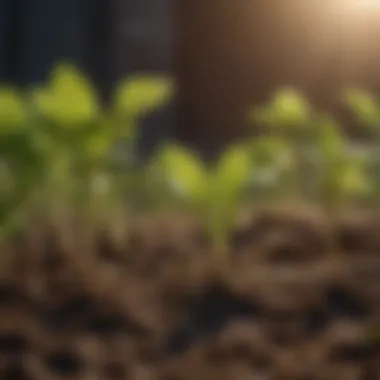

Technological Aids and Apps
In this digital age, technology is at one’s fingertips, and plant identification applications have stepped into the spotlight. These apps are designed to cater to both amateurs and professionals, allowing quick identification from just a photo of the seedling. Let's explore two particular types that have gained traction: Plant Identification Apps and Photo Libraries.
Plant Identification Apps
Plant Identification Apps are game-changers in the world of seedling identification. One significant aspect of these applications is their ease of use. By simply snapping a photo, users can receive quick feedback about the seedling in question.
A key characteristic of these apps is their extensive databases. They often include a vast array of plant species, making them a popular choice for identification tasks. For instance, apps like PlantSnap or PictureThis offer search functions based on images, enabling users to gain insights almost instantly.
The unique feature of many of these apps lies in their community-driven databases. Users can contribute images and information, gradually enhancing the app's effectiveness. But it's crucial to keep in mind that while this collaborative approach has advantages in extensive data generation, it can sometimes result in inconsistencies due to variable input quality. Furthermore, a lack of internet connection can hinder usability, which is worth considering when venturing into remote areas.
Photo Libraries
Photo Libraries provide another rich resource for identifying seedlings. These archives serve as visual catalogs, often brimming with high-quality images of different plant species. A significant aspect of these libraries is their comprehensive nature, often featuring detailed photographs that expose all the little nuances of each seedling.
A notable characteristic of photo libraries is their accessibility; many are available online and can be accessed anytime one might find themselves stuck without a physical guide. They are especially beneficial for someone who learns visually and has a penchant for referencing images continuously.
Nonetheless, photo libraries can sometimes lack the depth of information that you’d find in a text-based field guide. Additionally, navigating through innumerable pictures might become overwhelming, especially for those less tech-savvy or unsure about what to look for.
Overall, leveraging these tools can drastically improve your seedling identification skills, and they work harmoniously in combining traditional techniques with modern conveniences to guide you on the way to being an expert in seedling recognition.
Case Studies in Seedling Identification
When it comes to understanding seedlings, the importance of case studies can’t be overstated. These real-world examples not only shed light on practical identification techniques but also demonstrate the consequences of accurate and inaccurate seedling recognition. For agriculturalists and horticulturists alike, these instances can be a treasure trove of insights, showing how theory translates into practice.
Through careful study of successful identification practices, one can grasp the nuances and subtleties that theoretical knowledge alone might overlook. Identifying seedlings correctly can lead to healthier crops, sustainable cultivation, and an overall boost in agricultural productivity. Moreover, understanding common pitfalls can aid in avoiding costly mistakes, which makes analyzing case studies a critical part of any comprehensive guide on seedling identification.
Successful Identification Practices
Successful identification starts with observing various morphological features. For example, differentiating between seedling varieties based on leaf shape, color, and arrangement offers a solid foundation. Utilizing a simple guide allows for quick referencing; a chart with common seedlings, noting distinctions and similarities, can be a great tool.
Here are some practices that have proven effective:
- Field Observations: Spend time in local gardens or farms to see the seedlings in different growth stages. Note the environmental conditions impacting their growth.
- Documentation: Maintain a logbook to record characteristics and conditions of identified seedlings, helping refine identification skills over time.
- Community Engagement: Join local gardening clubs or online forums like reddit.com to gain insights from fellow gardening enthusiasts.
"Hands-on experience is often the best teacher. Observing closely and keeping a record can lead to successful identification and make learning enjoyable."
By combining experience with knowledge, one can create a rich understanding of seedlings that goes beyond identification alone.
Mistakes to Avoid
Mistakes in seedling identification can lead to adverse consequences, both environmentally and economically. Here are notable examples of common blunders:
- Neglecting Morphological Differences: Failing to recognize subtle distinctions between seedlings can lead to wrong conclusions. For instance, confusing certain types of ferns with similar-looking weeds is a frequent error.
- Ignoring the Environment: Overlooking the grown conditions, such as soil type and climate, can skew identification. A seedling flourishing in a specific environment might not be viable when conditions change.
- Over-relying on Technology: While plant identification apps can be handy, they are not foolproof. Relying solely on automated identification without manual confirmation is a trap many fall into.
To mitigate these mistakes, keep an open mind and always go back to fundamentals. Peer discussions can often clarify uncertainties. Cross-referencing different sources, such as britannica.com, can provide another layer of confidence in your identification skills.
Closure and Future Directions
As we wrap up our exploration of seedling identification, it becomes clear that understanding this topic is not just a matter of academic interest; it has real, tangible implications for the way we engage with our environments. Accurate seedling identification leads to better agricultural practices, enhancing crop yields and contributing to food security. Knowledge empowers farmers and gardening enthusiasts alike to make informed choices about planting, resulting in more sustainable outcomes.
The path forward is bright. As technology continues to advance, the tools available for seedling identification will only get better. Mobile applications that utilize image recognition are on the rise. Moreover, the integration of artificial intelligence is paving the way for instantaneous identification, allowing for unprecedented efficiency in the field. These tools not only help in identification but also in understanding specific species requirements, which ultimately aids in nurturing plants effectively.
However, despite these advancements, field-study remains irreplaceable. Nothing substitutes the experience of observing seedlings in their natural environment. There's a unique knowledge that comes from hands-on practice, learning to read the subtle cues that photographs can't always capture. While technology assists us, cultivating a relationship with the ecosystem will remain vital.
"The greatest discovery of all time is that a person can change their future by merely changing their attitude." - Oprah Winfrey.
In the spirit of these words, future directions in seedling identification will ideally strike a balance between technology and traditional knowledge. As we embrace these tools, let's not forget to ground our practices in ecological understanding and respect for biodiversity. Such an approach will ensure that we are not just participants in the agricultural landscape but also stewards of it.
Summary of Key Points
- Correct seedling identification is integral for effective gardening and farming.
- Advancements in technology, notably mobile apps, are enhancing our ability to identify plant species efficiently.
- Despite tech improvements, fieldwork and hands-on experience remain essential for in-depth understanding.
- A combined approach of technology and traditional knowledge will yield the best outcomes for sustainable practices.
Implications for Sustainable Agriculture
Incorporating proper seedling identification practices contributes significantly to sustainable agriculture. First, recognizing various species allows growers to select the right plants for their specific soil and climate conditions. This tailor-fit approach improves crop resilience and productivity, thereby reducing reliance on chemical interventions like pesticides or fertilizers.
Additionally, understanding local seedling varieties can lead to enhanced biodiversity. Widespread use of native species promotes healthier ecosystems and aids in conservation efforts. For example, planting native seedling varieties can improve soil health, attract beneficial insects, and support local wildlife.
Moreover, as farmers gain the knowledge to effectively identify and grow seedlings, they can manage their agricultural systems more sustainably. By rotating crops, intercropping, or employing cover crops alongside appropriate seedlings, they foster soil vitality and encourage a balanced ecosystem.



